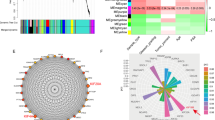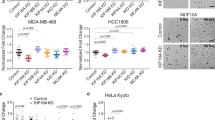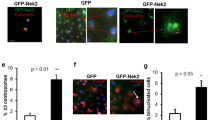Abstract
Breast cancer pathobiology is known to be influenced by the differential expression of a group of proteins called the kinesin superfamily (KIFs), which is instrumental in the intracellular transport of chromosomes along microtubules during mitosis. During cellular division, kinesins are strictly regulated through temporal synthesis so that they are present only when needed. However, their misregulation may contribute to uncontrolled cell growth owing to premature sister chromatid separation, highlighting their importance in cancer. This review covers the functions of kinesins in normal and breast cancer cells, the use of kinesins for breast cancer patient prognosis, and the targeting of these molecules for therapeutics. A better understanding of KIF proteins may be pivotal to improved disease outcomes for breast cancer patients.
This is a preview of subscription content, access via your institution
Access options
Subscribe to this journal
Receive 50 print issues and online access
$259.00 per year
only $5.18 per issue
Buy this article
- Purchase on Springer Link
- Instant access to full article PDF
Prices may be subject to local taxes which are calculated during checkout



Similar content being viewed by others
References
Ferlay J, Soerjomataram I, Dikshit R, Eser S, Mathers C, Rebelo M et al. Cancer incidence and mortality worldwide: sources, methods and major patterns in GLOBOCAN 2012. Int J Cancer 2015; 136: E359–386.
Vale RD, Reese TS, Sheetz MP . Identification of a novel force-generating protein, kinesin, involved in microtubule-based motility. Cell 1985; 42: 39–50.
Miki H, Setou M, Kaneshiro K, Hirokawa N . All kinesin superfamily protein, KIF, genes in mouse and human. Proc Natl Acad Sci USA 2001; 98: 7004–7011.
Lawrence CJ, Dawe RK, Christie KR, Cleveland DW, Dawson SC, Endow SA et al. A standardized kinesin nomenclature. J Cell Biol 2004; 167: 19–22.
Aizawa H, Sekine Y, Takemura R, Zhang Z, Nangaku M, Hirokawa N . Kinesin family in murine central nervous system. J Cell Biol 1992; 119: 1287–1296.
Diefenbach RJ, Mackay JP, Armati PJ, Cunningham AL . The C-terminal region of the stalk domain of ubiquitous human kinesin heavy chain contains the binding site for kinesin light chain. Biochemistry 1998; 37: 16663–16670.
Goldstein LS, Philp AV . The road less traveled: emerging principles of kinesin motor utilization. Annu Rev Cell Dev Biol 1999; 15: 141–183.
Castillo A, Morse HC 3rd, Godfrey VL, Naeem R, Justice MJ . Overexpression of Eg5 causes genomic instability and tumor formation in mice. Cancer Res 2007; 67: 10138–10147.
Wordeman L . How kinesin motor proteins drive mitotic spindle function: Lessons from molecular assays. Semin Cell Dev Biol 2010; 21: 260–268.
Oki E, Hisamatsu Y, Ando K, Saeki H, Kakeji Y, Maehara Y . Clinical aspect and molecular mechanism of DNA aneuploidy in gastric cancers. J Gastroenterol 2012; 47: 351–358.
Liu XR, Cai Y, Cao X, Wei RC, Li HL, Zhou XM et al. A new oncolytic adenoviral vector carrying dual tumour suppressor genes shows potent anti-tumour effect. J Cell Mol Med 2012; 16: 1298–1309.
Hirokawa N . Cross-linker system between neurofilaments, microtubules, and membranous organelles in frog axons revealed by the quick-freeze, deep-etching method. J Cell Biol 1982; 94: 129–142.
Brady ST . A novel brain ATPase with properties expected for the fast axonal transport motor. Nature 1985; 317: 73–75.
Hirokawa N . Kinesin and dynein superfamily proteins and the mechanism of organelle transport. Science 1998; 279: 519–526.
Yang JT, Laymon RA, Goldstein LS . A three-domain structure of kinesin heavy chain revealed by DNA sequence and microtubule binding analyses. Cell 1989; 56: 879–889.
Okada Y, Hirokawa N . Mechanism of the single-headed processivity: diffusional anchoring between the K-loop of kinesin and the C terminus of tubulin. Proc Natl Acad Sci USA 2000; 97: 640–645.
Okada Y, Yamazaki H, Sekine-Aizawa Y, Hirokawa N . The neuron-specific kinesin superfamily protein KIF1A is a unique monomeric motor for anterograde axonal transport of synaptic vesicle precursors. Cell 1995; 81: 769–780.
Svoboda K, Schmidt CF, Schnapp BJ, Block SM . Direct observation of kinesin stepping by optical trapping interferometry. Nature 1993; 365: 721–727.
Rice S, Lin AW, Safer D, Hart CL, Naber N, Carragher BO et al. A structural change in the kinesin motor protein that drives motility. Nature 1999; 402: 778–784.
Hirokawa N, Pfister KK, Yorifuji H, Wagner MC, Brady ST, Bloom GS . Submolecular domains of bovine brain kinesin identified by electron microscopy and monoclonal antibody decoration. Cell 1989; 56: 867–878.
Sanhaji M, Friel CT, Wordeman L, Louwen F, Yuan J . Mitotic centromere-associated kinesin (MCAK): a potential cancer drug target. Oncotarget 2011; 2: 935–947.
Dagenbach EM, Endow SA . A new kinesin tree. J Cell Sci 2004; 117: 3–7.
Wang L, Brown A . Rapid movement of microtubules in axons. Curr Biol 2002; 12: 1496–1501.
Cyr JL, Pfister KK, Bloom GS, Slaughter CA, Brady ST . Molecular genetics of kinesin light chains: generation of isoforms by alternative splicing. Proc Natl Acad Sci USA 1991; 88: 10114–10118.
Saxton WM, Hicks J, Goldstein LS, Raff EC . Kinesin heavy chain is essential for viability and neuromuscular functions in Drosophila, but mutants show no defects in mitosis. Cell 1991; 64: 1093–1102.
Hurd DD, Saxton WM . Kinesin mutations cause motor neuron disease phenotypes by disrupting fast axonal transport in Drosophila. Genetics 1996; 144: 1075–1085.
Rosenbaum JL, Witman GB . Intraflagellar transport. Nat Rev Mol Cell Biol 2002; 3: 813–825.
Nonaka S, Tanaka Y, Okada Y, Takeda S, Harada A, Kanai Y et al. Randomization of left-right asymmetry due to loss of nodal cilia generating leftward flow of extraembryonic fluid in mice lacking KIF3B motor protein. Cell 1998; 95: 829–837.
Skold HN, Komma DJ, Endow SA . Assembly pathway of the anastral Drosophila oocyte meiosis I spindle. J Cell Sci 2005; 118: 1745–1755.
Kapitein LC, Peterman EJ, Kwok BH, Kim JH, Kapoor TM, Schmidt CF . The bipolar mitotic kinesin Eg5 moves on both microtubules that it crosslinks. Nature 2005; 435: 114–118.
Hallen MA, Liang ZY, Endow SA . Ncd motor binding and transport in the spindle. J Cell Sci 2008; 121: 3834–3841.
Scanlan MJ, Gout I, Gordon CM, Williamson B, Stockert E, Gure AO et al. Humoral immunity to human breast cancer: antigen definition and quantitative analysis of mRNA expression. Cancer Immun 2001; 1: 4.
Corson TW, Gallie BL . KIF14 mRNA expression is a predictor of grade and outcome in breast cancer. Int J Cancer 2006; 119: 1088–1094.
Wang J, Ma S, Ma R, Qu X, Liu W, Lv C et al. KIF2A silencing inhibits the proliferation and migration of breast cancer cells and correlates with unfavorable prognosis in breast cancer. BMC Cancer 2014; 14: 461.
Wang C, Wang C, Wei Z, Li Y, Wang W, Li X et al. Suppression of motor protein KIF3C expression inhibits tumor growth and metastasis in breast cancer by inhibiting TGF-beta signaling. Cancer Lett 2015; 368: 105–114.
Shimo A, Tanikawa C, Nishidate T, Lin ML, Matsuda K, Park JH et al. Involvement of kinesin family member 2C/mitotic centromere-associated kinesin overexpression in mammary carcinogenesis. Cancer Sci 2008; 99: 62–70.
Ahmed SM, Theriault BL, Uppalapati M, Chiu CW, Gallie BL, Sidhu SS et al. KIF14 negatively regulates Rap1a-Radil signaling during breast cancer progression. J Cell Biol 2012; 199: 951–967.
Suzuki K, Takahashi K . Regulation of lamellipodia formation and cell invasion by CLIP-170 in invasive human breast cancer cells. Biochem Biophys Res Commun 2008; 368: 199–204.
Takahashi K, Suzuki K . Requirement of kinesin-mediated membrane transport of WAVE2 along microtubules for lamellipodia formation promoted by hepatocyte growth factor. Exp Cell Res 2008; 314: 2313–2322.
Zhang C, Zhu C, Chen H, Li L, Guo L, Jiang W et al. Kif18A is involved in human breast carcinogenesis. Carcinogenesis 2010; 31: 1676–1684.
Kim S, Lee K, Choi JH, Ringstad N, Dynlacht BD . Nek2 activation of Kif24 ensures cilium disassembly during the cell cycle. Nat Commun 2015; 6: 8087.
Groth-Pedersen L, Aits S, Corcelle-Termeau E, Petersen NH, Nylandsted J, Jaattela M . Identification of cytoskeleton-associated proteins essential for lysosomal stability and survival of human cancer cells. PLoS One 2012; 7: e45381.
Cardoso CM, Groth-Pedersen L, Hoyer-Hansen M, Kirkegaard T, Corcelle E, Andersen JS et al. Depletion of kinesin 5B affects lysosomal distribution and stability and induces peri-nuclear accumulation of autophagosomes in cancer cells. PLoS One 2009; 4: e4424.
Kasahara M, Nagahara M, Nakagawa T, Ishikawa T, Sato T, Uetake H et al. Clinicopathological relevance of kinesin family member 18A expression in invasive breast cancer. Oncol Lett 2016; 12: 1909–1914.
Wang Q, Zhao ZB, Wang G, Hui Z, Wang MH, Pan JF et al. High expression of KIF26B in breast cancer associates with poor prognosis. PLoS One 2013; 8: e61640.
Zou JX, Duan Z, Wang J, Sokolov A, Xu J, Chen CZ et al. Kinesin family deregulation coordinated by bromodomain protein ANCCA and histone methyltransferase MLL for breast cancer cell growth, survival, and tamoxifen resistance. Mol Cancer Res 2014; 12: 539–549.
Pannu V, Rida PC, Ogden A, Turaga RC, Donthamsetty S, Bowen NJ et al. HSET overexpression fuels tumor progression via centrosome clustering-independent mechanisms in breast cancer patients. Oncotarget 2015; 6: 6076–6091.
Li Y, Lu W, Chen D, Boohaker RJ, Zhai L, Padmalayam I et al. KIFC1 is a novel potential therapeutic target for breast cancer. Cancer Biol Ther 2015; 16: 1316–1322.
De S, Cipriano R, Jackson MW, Stark GR . Overexpression of kinesins mediates docetaxel resistance in breast cancer cells. Cancer Res 2009; 69: 8035–8042.
Singel SM, Cornelius C, Batten K, Fasciani G, Wright WE, Lum L et al. A targeted RNAi screen of the breast cancer genome identifies KIF14 and TLN1 as genes that modulate docetaxel chemosensitivity in triple-negative breast cancer. Clin Cancer Res 2013; 19: 2061–2070.
Singel SM, Cornelius C, Zaganjor E, Batten K, Sarode VR, Buckley DL et al. KIF14 promotes AKT phosphorylation and contributes to chemoresistance in triple-negative breast cancer. Neoplasia 2014; 16: 247–256, 256 e242.
Tan MH, De S, Bebek G, Orloff MS, Wesolowski R, Downs-Kelly E et al. Specific kinesin expression profiles associated with taxane resistance in basal-like breast cancer. Breast Cancer Res Treat 2012; 131: 849–858.
Ganguly A, Yang H, Cabral F . Overexpression of mitotic centromere-associated Kinesin stimulates microtubule detachment and confers resistance to paclitaxel. Mol Cancer Ther 2011; 10: 929–937.
Khongkow P, Gomes AR, Gong C, Man EP, Tsang JW, Zhao F et al. Paclitaxel targets FOXM1 to regulate KIF20A in mitotic catastrophe and breast cancer paclitaxel resistance. Oncogene 2016; 35: 990–1002.
Froidevaux-Klipfel L, Poirier F, Boursier C, Crepin R, Pous C, Baudin B et al. Modulation of septin and molecular motor recruitment in the microtubule environment of the Taxol-resistant human breast cancer cell line MDA-MB-231. Proteomics 2011; 11: 3877–3886.
Blangy A, Lane HA, d'Herin P, Harper M, Kress M, Nigg EA . Phosphorylation by p34cdc2 regulates spindle association of human Eg5, a kinesin-related motor essential for bipolar spindle formation in vivo. Cell 1995; 83: 1159–1169.
Weil D, Garcon L, Harper M, Dumenil D, Dautry F, Kress M . Targeting the kinesin Eg5 to monitor siRNA transfection in mammalian cells. Biotechniques 2002; 33: 1244–1248.
Sakowicz R, Finer JT, Beraud C, Crompton A, Lewis E, Fritsch A et al. Antitumor activity of a kinesin inhibitor. Cancer Res 2004; 64: 3276–3280.
Gomez HL, Philco M, Pimentel P, Kiyan M, Monsalvo ML, Conlan MG et al. Phase I dose-escalation and pharmacokinetic study of ispinesib, a kinesin spindle protein inhibitor, administered on days 1 and 15 of a 28-day schedule in patients with no prior treatment for advanced breast cancer. Anticancer Drugs 2012; 23: 335–341.
De Iuliis F, Taglieri L, Salerno G, Giuffrida A, Milana B, Giantulli S et al. The kinesin Eg5 inhibitor K858 induces apoptosis but also survivin-related chemoresistance in breast cancer cells. Invest New Drugs 2016; 34: 399–406.
Holen KD, Belani CP, Wilding G, Ramalingam S, Volkman JL, Ramanathan RK et al. A first in human study of SB-743921, a kinesin spindle protein inhibitor, to determine pharmacokinetics, biologic effects and establish a recommended phase II dose. Cancer Chemother Pharmacol 2011; 67: 447–454.
Zhu L, Xiao F, Yu Y, Wang H, Fang M, Yang Y et al. KSP inhibitor SB743921 inhibits growth and induces apoptosis of breast cancer cells by regulating p53, Bcl-2, and DTL. Anticancer Drugs 2016; 27: 863–872.
Banerjee M, Singh P, Panda D . Curcumin suppresses the dynamic instability of microtubules, activates the mitotic checkpoint and induces apoptosis in MCF-7 cells. FEBS J 2010; 277: 3437–3448.
Shankaraiah N, Nekkanti S, Chudasama KJ, Senwar KR, Sharma P, Jeengar MK et al. Design, synthesis and anticancer evaluation of tetrahydro-beta-carboline-hydantoin hybrids. Bioorg Med Chem Lett 2014; 24: 5413–5417.
Guido BC, Ramos LM, Nolasco DO, Nobrega CC, Andrade BY, Pic-Taylor A et al. Impact of kinesin Eg5 inhibition by 3,4-dihydropyrimidin-2(1H)-one derivatives on various breast cancer cell features. BMC Cancer 2015; 15: 283.
Yoon JR, Whipple RA, Balzer EM, Cho EH, Matrone MA, Peckham M et al. Local anesthetics inhibit kinesin motility and microtentacle protrusions in human epithelial and breast tumor cells. Breast Cancer Res Treat 2011; 129: 691–701.
Wu J, Mikule K, Wang W, Su N, Petteruti P, Gharahdaghi F et al. Discovery and mechanistic study of a small molecule inhibitor for motor protein KIFC1. ACS Chem Biol 2013; 8: 2201–2208.
Zhang W, Zhai L, Wang Y, Boohaker RJ, Lu W, Gupta VV et al. Discovery of a novel inhibitor of kinesin-like protein KIFC1. Biochem J 2016; 473: 1027–1035.
Wang H, Lu C, Li Q, Xie J, Chen T, Tan Y et al. The role of Kif4A in doxorubicin-induced apoptosis in breast cancer cells. Mol Cells 2014; 37: 812–818.
Guerrero-Preston R, Hadar T, Ostrow KL, Soudry E, Echenique M, Ili-Gangas C et al. Differential promoter methylation of kinesin family member 1a in plasma is associated with breast cancer and DNA repair capacity. Oncol Rep 2014; 32: 505–512.
Ostrow KL, Park HL, Hoque MO, Kim MS, Liu J, Argani P et al. Pharmacologic unmasking of epigenetically silenced genes in breast cancer. Clin Cancer Res 2009; 15: 1184–1191.
Corson TW, Huang A, Tsao MS, Gallie BL . KIF14 is a candidate oncogene in the 1q minimal region of genomic gain in multiple cancers. Oncogene 2005; 24: 4741–4753.
Itzel T, Scholz P, Maass T, Krupp M, Marquardt JU, Strand S et al. Translating bioinformatics in oncology: guilt-by-profiling analysis and identification of KIF18B and CDCA3 as novel driver genes in carcinogenesis. Bioinformatics 2015; 31: 216–224.
Feng YM, Gao G, Zhang F, Chen H, Wan YF, Li XQ . Identification of the differentially expressed genes between primary breast cancer and paired lymph node metastasis through combining mRNA differential display and gene microarray. Zhonghua Yi Xue Za Zhi 2006; 86: 2749–2755.
Feng YM, Wan YF, Li XQ, Cao XC, Li X . Expression and clinical significance of KNSL4 in breast cancer. Ai Zheng 2006; 25: 744–748.
Acknowledgements
The technical assistance of SL Bay in the preparation of Figure 1 is deeply appreciated. Work in the laboratory of GW Yip is supported by Grants NMRC/CSA/0041/2012 and NMRC/CIRG/1436/2015 from the National Medical Research Council, Singapore. AJ Lucanus thanks the Australian Government’s Department of Foreign Affairs and Trade for the New Colombo Plan Scholarship. We apologise for the use of review articles and the failure to cite many relevant primary articles as a result of space constraints.
Author information
Authors and Affiliations
Corresponding author
Ethics declarations
Competing interests
The authors declare no conflict of interest.
Rights and permissions
About this article
Cite this article
Lucanus, A., Yip, G. Kinesin superfamily: roles in breast cancer, patient prognosis and therapeutics. Oncogene 37, 833–838 (2018). https://doi.org/10.1038/onc.2017.406
Received:
Revised:
Accepted:
Published:
Issue Date:
DOI: https://doi.org/10.1038/onc.2017.406
This article is cited by
-
KIF2C is a prognostic biomarker associated with immune cell infiltration in breast cancer
BMC Cancer (2023)
-
Kinesin family member 18B activates mTORC1 signaling via actin gamma 1 to promote the recurrence of human hepatocellular carcinoma
Oncogenesis (2023)
-
Bioinformatical analysis of the key differentially expressed genes for screening potential biomarkers in Wilms tumor
Scientific Reports (2023)
-
KIF14 promotes proliferation, lymphatic metastasis and chemoresistance through G3BP1/YBX1 mediated NF-κB pathway in cholangiocarcinoma
Oncogene (2023)
-
Kinesin family member 23 knockdown inhibits cell proliferation and epithelial-mesenchymal transition in esophageal carcinoma by inactivating the Wnt/β-catenin pathway
Functional & Integrative Genomics (2023)



